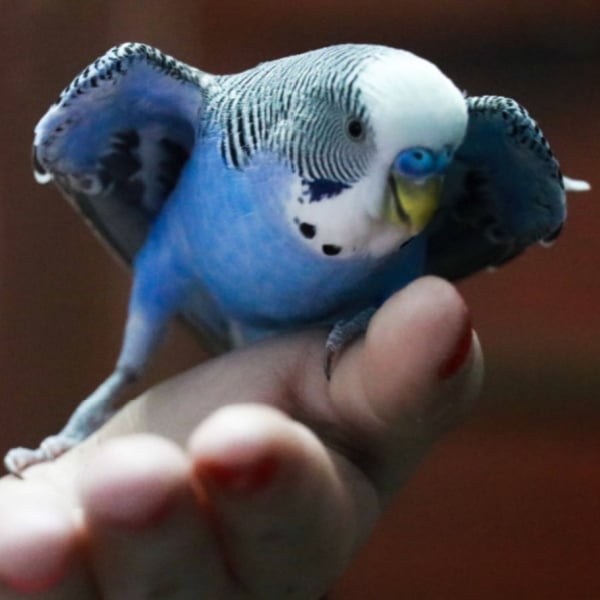
Holy Crap, My Budgie’s Toe Is Gushing Blood And Nothing Is Stopping It!
Last Updated on by Catherine Tobsing
How to Deal With Nail Bleeding Emergencies and Other Minor Foot Bleeding Accidents
Hi, I’m Nora Caterino.
Some of you may know me from other parrot-related websites from my pasts, but for you of those to whom I am new, I have over 25 years of small and medium parrot experience.
I began as the ‘owner’ of a single tame parakeet and eventually became a parrot parent and web and magazine published expert.
I quickly realized we don’t own the majestic birds who share our homes; they deign to allow themselves (in well-socialized parrots in good homes) to be our trusted companions and, to a great extent, own us.
I have rescued several rehomes from really bad circumstances.
At times, it was a challenge to maintain a manageable flock size but taking on more birds than can be done justice in every way is a disservice to these elegant social creatures and to your sanity.
When in Florida, my adopted home, avian vets are common and most are very good.
My sun conure had passed from age and my budgie had bonded with a friend’s budgie whose home I was sharing, so knowing my budgie would be in good hands and have company, I went to visit my mother — not realizing her health would prevent me from returning for 9 years.
Mom loved parrots too, and soon someone wanted to rehome a pair of male cockatiels and cages.
We accepted. Someone who no longer could care for their young sun conure needed to rehome her and she was a delight.
Soon two budgies, male and female, came to join our flock, entertaining mother for endless hours as she became less and less mobile.
That was the limit because between caring for the birds and her increasing care needs; it would not have been fair to accept another rehome, but I did help a number of people locate others willing to rehome their birds when needed. In a future post, we’ll talk about some of the reasons all these rehomes are available.
I had learned there was no avian vet with about 200 miles of our rather small rural city.
That is fine for a yearly check-up but doesn’t help at all during emergencies.
I had become friends with two local vets but they were not qualified to treat my birds and acknowledged it; however, they were happy to give any advice they could if they felt it would be helpful and not harmful.
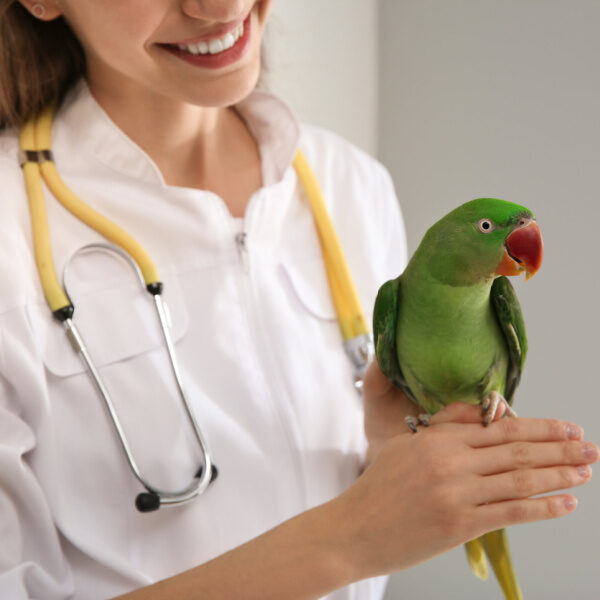
In this small town, clipping nails and wings were up to the owner.
There was not even a pet shop that provided the service.
My phone number eventually ended up in many parrot parents’ little black books because they could find it on my website and I’d come to help them with these normally simple matters.
I always took my first aid kit just in case but never had to use it because I knew both the Zombie Death Grip and toweling, which one or the other or a combination of both will secure any parrot.
One day, it was nail trimming day at my house. Mother had fragile skin common to the elderly and I had to watch nail length for her safety. But after all, what could possibly happen after all these years without incident?
Most of the birds were pretty calm about nail trimming, knowing it didn’t last long and that treats followed.
The little female budgie, Precious, was the least tame and most rambunctious about grooming.
She fought the toweling and restrained every single time no matter how great the treats afterward might taste.
I clipped the other four without incident.
In almost all cases, when a parrot objects to nail clipping, they will make every effort to jerk their toe away, backward, from the clipping tool.
All the others birds had tried just this, with no success.
Precious had seen them each get their generous tasty treats after the very short procedure.
Any other budgie would have been eager for her turn in order to retrieve her luscious treats.
Not our Precious. She was plotting ways to avoid being grasped in the Zombie Grip and toweled (yes, she required both methods combined each time because she was such a little fighter).
I got her securely in grasp and exposed one foot from the towel so I could work on it.
I grasped a single toe in one set of fingers and positioned the clipping tool in place with the other. It would be really nice to have four arms when clipping birds like Precious!
Precious’ plot had been to avoid pulling away from the tool, instead of trying to try to stop me by inserting her nail further into the tool.
She didn’t advise me of this plan in advance and performed her movement at the precise moment I was closing the clippers, resulting in an extremely over-clipped claw.
The vein that runs inside a bird’s nail can act like a straw, sucking the blood right out just as does a blood feather.
Unless the bleeding is stopped quickly, a combination of too much stress and excessive blood loss can kill the bird pretty quickly.
Parakeets (budgies) are so small, they don’t require much time to lose a whole lot of blood and she was bleeding profusely.
I asked Mother to grab the first aid kit. But my immediate line of attacking the problem was the nearby flour container.
Often clean flour applied in a clump between two fingers pressing firmly for pressure will stop bleeding nails fast and simply.
Unfortunately this time it had no impact on the level of blood flowing from the nail.
Feeling that I might be forming a bit of clot and not wanting to disturb it, I added an ice chip to the pressure for a short time just to see if it might avoid dislodging any building clot and avoid further stress to the budgie.
No improvement. I held her so that her foot was above her rapidly beating little heart while still maintaining pressure on the flour-coated nail.
Still no improvement.
By this time, Mother was in the kitchen with the first aid kit and already had the coagulant powder out for me and the cap off the small container.
A container of coagulant powder (corn starch or bar soap can work in a pinch) should be in every first aid kit and it should be replaced with fresh powder at least once per year since freshness counts in how well it acts.
That last statement may not be fact, I’ve not researched it but it is my personal belief. I don’t take medication over one year old so I feel my parrots shouldn’t either.
I cleaned the bloody clump of flour away and applied the coagulant powder very generously, and then reapplied firm pressure to the wound.
Several minutes later there was still no staunching the blood flow.
By now I was beginning to panic a bit but hiding it well because it would not help me, the bird, and certainly not my 82-year-old mother.
I added ice to the combination, still with no result.
If it were not Saturday, I would phone my vet friend and ask for advice and/or help. But I correctly expected them to be off somewhere with family or friends or just relaxing and not available quickly by phone.
One was always on-call for emergencies but I needed help within seconds or minutes at most at this point.
An idea came to mind that I thought was worth a shot before I lost my precious little pal.
Cauterization is common in surgical procedures to stop bleeding and I decided to give a modified method of this before my bird possibly died.
Nothing was stopping the blood flow and this was the last resort I knew to attempt.
By this point, the blood loss looked massive; I’m sure it looked worse than it was, but I knew for a fact it was becoming serious.
I could tell the stress Precious was experiencing was taking a toll on her also.
Here’s how I managed to perform emergency cauterization to immediately stop the blood flow and allow Precious to begin recovery:
I grabbed a stainless steel butter knife while heating an electric stove eye on a high setting.
Gas would work just fine and probably faster but we cooked with electricity.
I placed just the tip of the knife blade on the now glowing stove coil and waited about 30 seconds so the blade had time to become hot – not glowing red hot but clearly hot –- too hot to touch with my bare hands.
Holding the hot knife in an oven mitt because the handle had become hot and the little bird securely in the other hand with her toe firmly between two fingers and just the nail exposed, I very carefully but very quickly touched the end of the hot knife blade to just the very tip of the bleeding nail for about as long as it took to say “one Mississippi, two Miss” (about 1.5 seconds) and removed it.
The blood had cauterized, burning to form a clot.
There was no seepage or bleeding.
I watched the bird carefully for quite a while.
She actually allowed Mom to place the towel in her lap and settled down on it so we knew she was tired.
Mom fed her treats and talked softly and lovingly to her.
Once we were sure the clot was holding we allowed her freedom, but did restrict her to her cage for easy observation for a while even though it was during out of the cage hours.
Strangely enough, in about 15 minutes my vet friend dropped by just to see how Mother and I were doing since we all felt a real sense of community in that little area.
I advised him of my actions and he said that while he uses an electric tool that looks vaguely like a soldering iron, his surgery uses the same method on larger animals and that I had acted perfectly in what was clearly becoming a critical situation.
My professional vet friend also told me that in foot wounds that are NOT very deep, the same method can be used. In deep foot wounds, the knife would have to be fully sterile to avoid introducing germs into the wound using this method and might cause more harm than good. But he also said that as a last-ditch effort in an emergency where no other help is available it could be worth a try even then.
I used very clean flatware, but it should have preferably been sterilized equipment. Even a dousing with rubbing alcohol would help. Fortunately, my knives were clean, and due to Mom’s health w
e keep extra-sterilized utensils washed in super-hot water but I still should have added alcohol, I just didn’t think of it in time.
In the most bird-safe homes, accidents and injuries can and do happen, even if infrequently.
Do be prepared with knowledge and equipment of the best things to do and ways to improvise in a pinch.
Precious lived a long and happy life though she never got over her fight against nail trimming.
It could easily have been a much-foreshortened life had I not been thinking fast that day and willing to act on my idea.
I wish all my stories were as happy. I want to thank Mitch for asking me to guest post and hope that he will ask me to do so often in the future.
I have missed writing about parrots since my return to Florida but my partner in past parrot website adventures married and is expecting a daughter any day now.
Until then, love and enjoy your parrots, friends, family, respect all life and the planet; dance as if no one were looking, and live every second to the maximum.
Written by the Windy City Parrot Content Team
Author Profile

Latest entries
 Bird & Parrot CareJune 20, 2025Understanding the Best Way to Use Prevue Pets Mimic Me Voice Trainer
Bird & Parrot CareJune 20, 2025Understanding the Best Way to Use Prevue Pets Mimic Me Voice Trainer Bird BehaviorJune 6, 2025How Do I Keep My Parrot From Dumping His Food Every Day?
Bird BehaviorJune 6, 2025How Do I Keep My Parrot From Dumping His Food Every Day?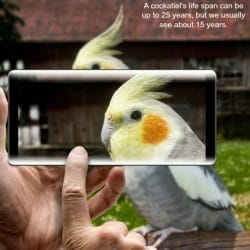 Birds & LightingMay 16, 2025I Am Seeking Clarity About Lighting for My Birds Cage
Birds & LightingMay 16, 2025I Am Seeking Clarity About Lighting for My Birds Cage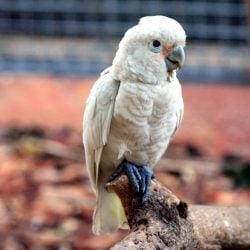 Bird RescueApril 29, 2025How Do We Re-Home a 17 yr Goffin Cockatoo?
Bird RescueApril 29, 2025How Do We Re-Home a 17 yr Goffin Cockatoo?
This Post Has One Comment
Leave a Reply
You must be logged in to post a comment.

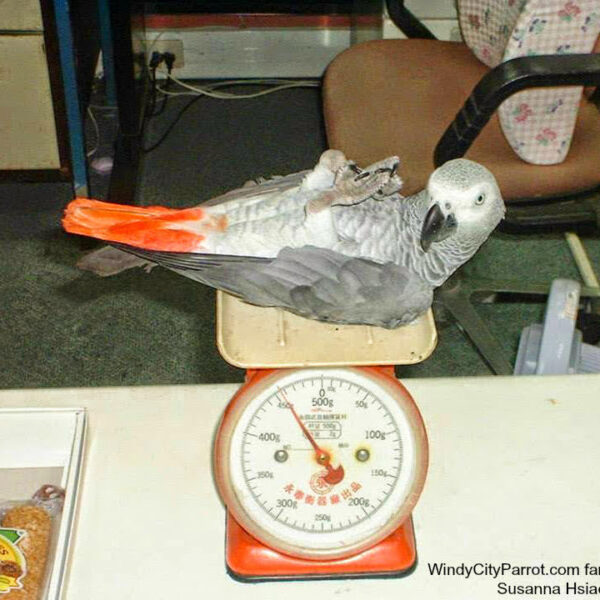

Rootbeer Ostrander
6 Apr 2017I will def. try this if the corn starch doesn’t work. I don’t think I cute her nails too deep though, so hopefully it works. Thanks for posting this!